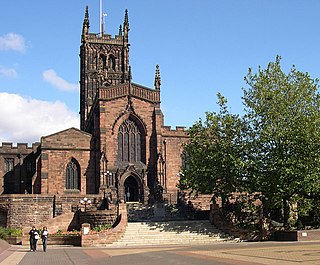
Saint Patrick's Cathedral in Dublin, Ireland, founded in 1191 as a Roman Catholic Cathedral, it is currently the national cathedral of the Church of Ireland. Christ Church Cathedral, also a Church of Ireland cathedral in Dublin, is designated as the local cathedral of the Diocese of Dublin and Glendalough.
Peter of Blois was a French cleric, theologian, poet and diplomat. He is particularly noted for his corpus of Latin letters.

A canon is a member of certain bodies in Christianity subject to an ecclesiastical rule.
A royal peculiar is a Church of England parish or church exempt from the jurisdiction of the diocese and the province in which it lies, and subject to the direct jurisdiction of the monarch, or in Cornwall by the duke.
A dean, in an ecclesiastical context, is a cleric holding certain positions of authority within a religious hierarchy. The title is used mainly in the Anglican Communion, the Roman Catholic Church, and many Lutheran denominations. A dean's assistant is called a sub-dean.
Robert of Shrewsbury was an English cleric, administrator, and judge of the Angevin period. His career culminated in his appointment as Bishop of Bangor.

The Diocese of Chester is a Church of England diocese in the Province of York covering the pre-1974 county of Cheshire and therefore including the Wirral and parts of Stockport, Trafford and Tameside.

The Dean of Windsor is the spiritual head of the canons of St George's Chapel at Windsor Castle, England. The dean chairs meetings of the Chapter of Canons as primus inter pares. The post of Dean of Wolverhampton was assimilated to the deanery of Windsor, around 1480, until 1846.

Dunston is a small village in England lying on the west side of the A449 trunk road about 3 miles (4.8 km) south of Stafford, close to Junction 13 of the M6 motorway. The population of the village at the 2011 census was 281. It lies at roughly 300 feet above sea level.
Robert Leighton Hodson was the second Bishop of Shrewsbury in the modern era.

St Peter's Collegiate Church is located in central Wolverhampton, England. For many centuries it was a chapel royal and from 1480 a royal peculiar, independent of the Diocese of Lichfield and even the Province of Canterbury. The collegiate church was central to the development of the town of Wolverhampton, much of which belonged to its dean. Until the 18th century, it was the only church in Wolverhampton and the control of the college extended far into the surrounding area, with dependent chapels in several towns and villages of southern Staffordshire.

Lilleshall Abbey was an Augustinian abbey in Shropshire, England, today located 6 miles (9.7 km) north of Telford. It was founded between 1145 and 1148 and followed the austere customs and observance of the Abbey of Arrouaise in northern France. It suffered from chronic financial difficulties and narrowly escaped the Dissolution of the Lesser Monasteries in 1536, before going into voluntary dissolution in 1538.
Priory of St. Thomas near Stafford was an Augustinian religious house near Stafford, Staffordshire, England. Founded sometime in approximately 1174, it was a surrendered to the Crown in 1538, during the Dissolution of the Monasteries.
Stafford Friary was a religious house of Franciscan friars in Stafford, Staffordshire, England. Founded sometime in the 13th century, it was a surrendered to the Crown in 1538, during the Dissolution of the Monasteries.
Henry Lewis Hobart was an English Anglican priest who became Dean of Windsor and thus Dean of Wolverhampton.
The Bishop of Chester is the Ordinary of the Church of England Diocese of Chester in the Province of York.

St. John's Church is a Grade II* listed Church of England parish church in Wolverhampton.
Wombridge Priory was a small Augustinian monastery in Shropshire. Established in the early 12th century, it was supported by a network of minor nobility and was never a large community. Despite generally good financial management, it fell within the scope of the Suppression of Religious Houses Act 1535 and was dissolved in the following year.

St Mary's Hospital was a medieval almshouse and chantry in Wolverhampton, associated with St Peter's Collegiate Church. It was founded in the 1390s and disappeared with the abolition of the chantries in the reign of Edward VI. The only vestige today is in the form of a street name.

The Church of St Peter and St Paul, Heytesbury is the Church of England parish church for the parish of Heytesbury with Tytherington and Knook, Wiltshire, England. It was a collegiate church from the 12th century until 1840. The present building is largely 13th-century and is designated as Grade I listed.










